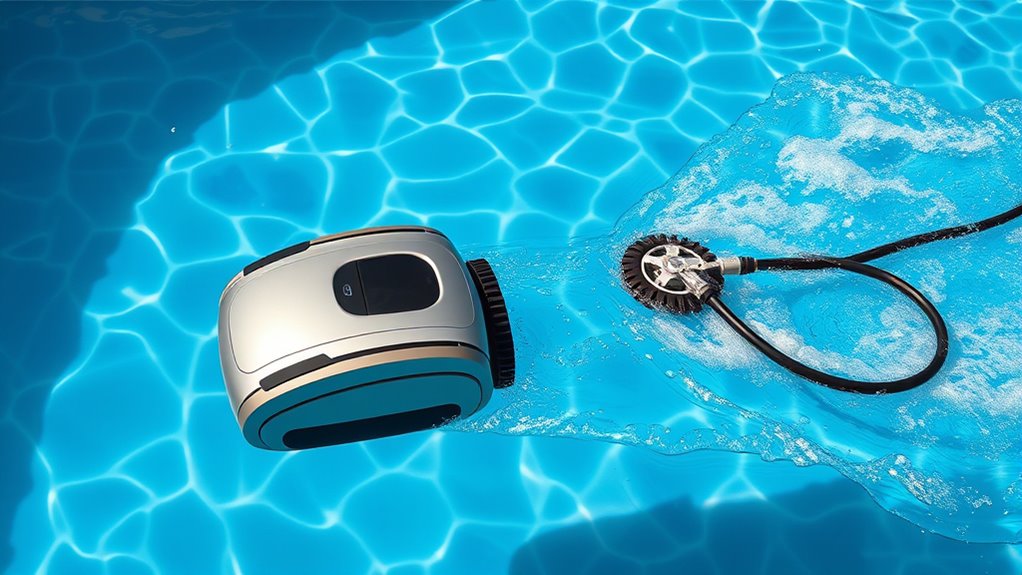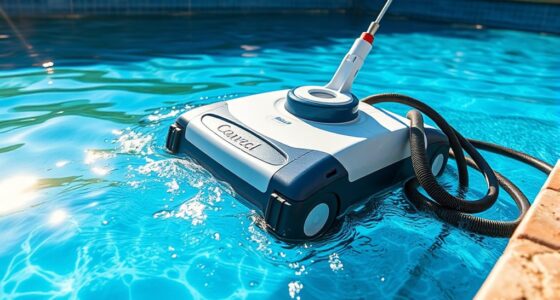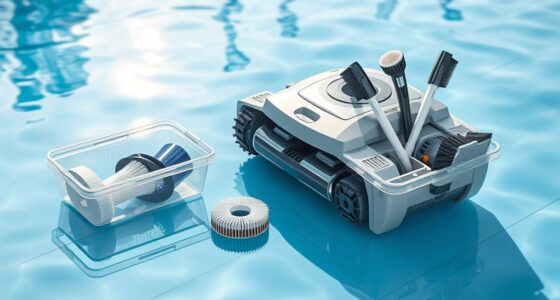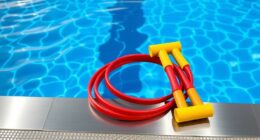When deciding between pressure and robotic pool cleaners, consider your pool’s size, shape, and debris type. Pressure models are budget-friendly and simple but rely on your pool’s existing system, making them better for straightforward pools. Robotic cleaners are more advanced, with better coverage and cleaning power, especially for irregular shapes, but they cost more upfront. To find the perfect fit for your needs, explore the detailed differences and benefits below.
Key Takeaways
- Robotic cleaners offer independent operation with advanced navigation and filtration, while pressure cleaners rely on existing pool systems for movement and cleaning.
- Robotic models typically have higher upfront costs but lower long-term maintenance and energy expenses compared to pressure cleaners.
- Pressure cleaners are more suitable for simple, smaller pools, whereas robotic cleaners excel at complex shapes and larger surfaces.
- Robotic cleaners provide faster, more thorough coverage with sensors and smart navigation, improving cleaning efficiency and effectiveness.
- Maintenance for robotic cleaners involves filter cleaning and brush replacement, while pressure cleaners mainly require hose and pump checks.
Overview of Pressure Pool Cleaners
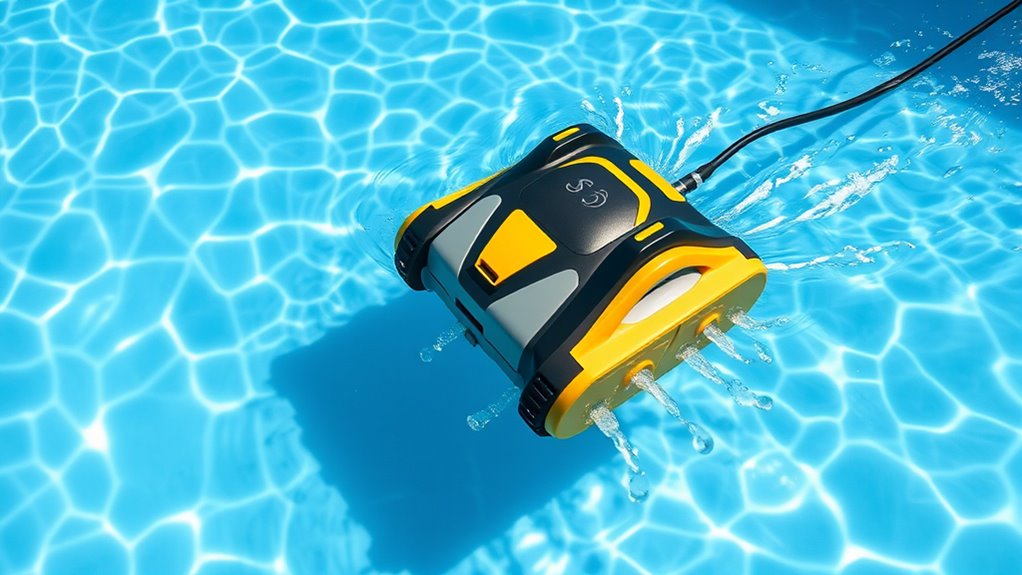
Pressure pool cleaners are automated devices that use high-pressure water to effectively scrub and vacuum your pool’s surfaces. They’re great for maintaining pool safety by preventing debris buildup that can cause slipping hazards or damage. These cleaners rely on your pool’s existing pump and filter system, making installation straightforward. Proper maintenance and regular testing are essential to keep the water safe and clear. Additionally, understanding the regulations surrounding pool equipment can help ensure safe and compliant operation. Pressure cleaners work well for larger debris and uneven surfaces, but you should stay attentive to their impact on water chemistry to ensure your pool remains safe, clean, and inviting. Since they utilize high-pressure water, they may also contribute to water chemistry disturbances, making monitoring pH and chemical levels crucial during use. Regularly inspecting the equipment and understanding how they interact with your pool’s filtration system can help prevent potential issues and prolong the lifespan of the cleaner. Furthermore, choosing the right pressure setting can optimize cleaning efficiency while minimizing equipment wear. Additionally, selecting a pressure cleaner with adjustable features can help prevent damage to pool surfaces and improve overall cleaning performance.
Overview of Robotic Pool Cleaners
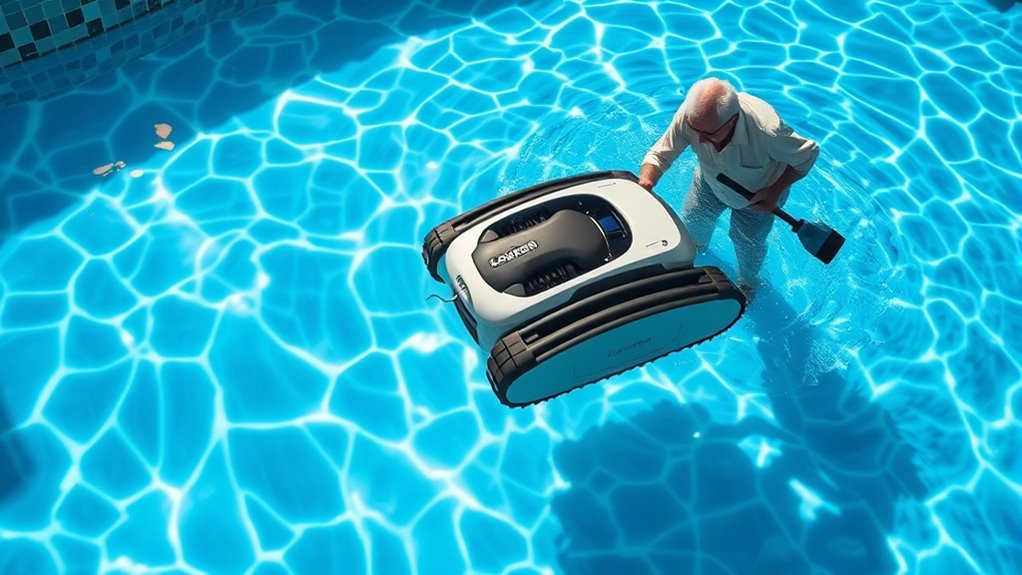
Robotic pool cleaners have become a popular choice for effortless pool maintenance because they operate independently without relying on your pool’s existing filtration system. These devices use their own water filtration to pick up debris, ensuring your pool stays clean with minimal effort. You’ll appreciate features like:
Robotic pool cleaners operate independently, using their own filtration to keep your pool effortlessly clean.
- Advanced Water Filtration: Effectively captures dirt, leaves, and algae, reducing the load on your main filter. Utilizing independent water filtration enhances their ability to maintain water clarity and cleanliness.
- Battery Life: Designed for extended cleaning cycles, so you can cover larger pools without interruptions.
- Ease of Use: Simply place the cleaner in the pool, and it navigates and cleans automatically, saving you time and effort. Autonomous Navigation capabilities further improve their efficiency by allowing the cleaner to adapt to different pool shapes and obstacles. Additionally, modern models often incorporate smart technology that allows for better mapping and cleaning patterns, further optimizing performance.
– Enhanced efficiency: Integrating Positive Thinking techniques can help pool owners stay motivated and patient during maintenance routines, making the experience more enjoyable.
Operating Mechanisms and Technology
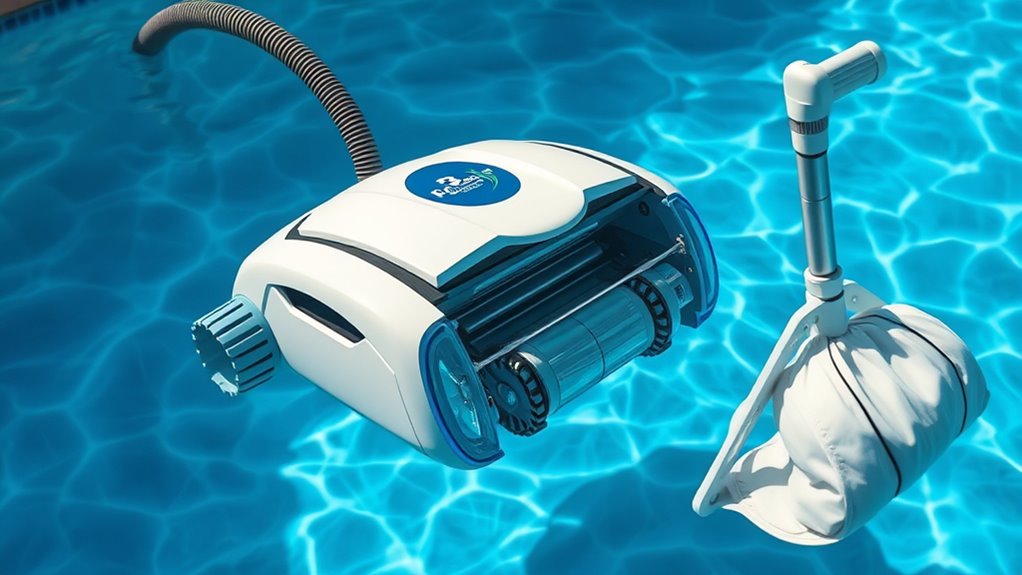
Robotic pool cleaners rely on a variety of innovative operating mechanisms and advanced technology to efficiently navigate and clean your pool. Hydraulic systems power their movement, using water pressure to propel the cleaner and optimize coverage. Sensor technology plays an essential role, enabling the robot to detect obstacles, identify dirt, and map the pool’s layout. These sensors guarantee the cleaner adjusts its path dynamically, avoiding missed spots and preventing collisions. Some models feature cliff sensors to prevent falls off the pool’s edge, while others use smart navigation systems for thorough cleaning. Overall, these mechanisms work together to enhance efficiency, reduce manual effort, and deliver a more effective cleaning process. This technology-driven approach makes robotic cleaners highly adaptable and reliable for maintaining pristine pool conditions. Understanding the technology behind robotic cleaners can help users choose the most effective model for their needs. Additionally, the integration of sensor technology allows for real-time adjustments, ensuring comprehensive coverage and optimal cleaning performance. The use of advanced navigation systems further improves the robot’s ability to cover the entire pool efficiently, enhancing overall cleaning accuracy.
Cost and Budget Considerations
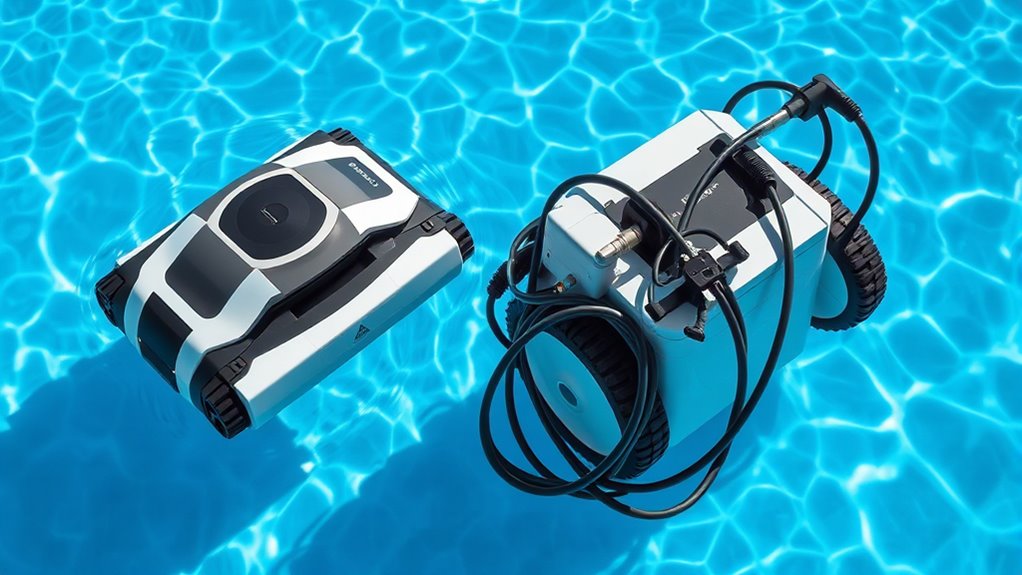
When considering pool cleaning options, cost is a key factor that can influence your decision. Your budget constraints and initial investment play pivotal roles in choosing between pressure and robotic cleaners. Here are three points to consider:
- Initial investment: Robotic cleaners tend to cost more upfront but often save money long-term with less maintenance. Investing in a cost-effective model can provide better value over time. Additionally, robotic cleaners often incorporate advanced technology that improves efficiency and cleaning performance.
- Operating costs: Pressure cleaners usually have lower initial prices but may require more frequent repairs or replacements.
- Budget flexibility: If you have a tight budget, a pressure cleaner might seem appealing, but investing in a robotic cleaner could offer better value over time.
Balancing your budget constraints with long-term savings helps you select the cleaner that fits your financial situation best. Additionally, selecting a suitable cleaning method that aligns with your specific pool needs can further optimize your investment.
Cleaning Performance and Effectiveness
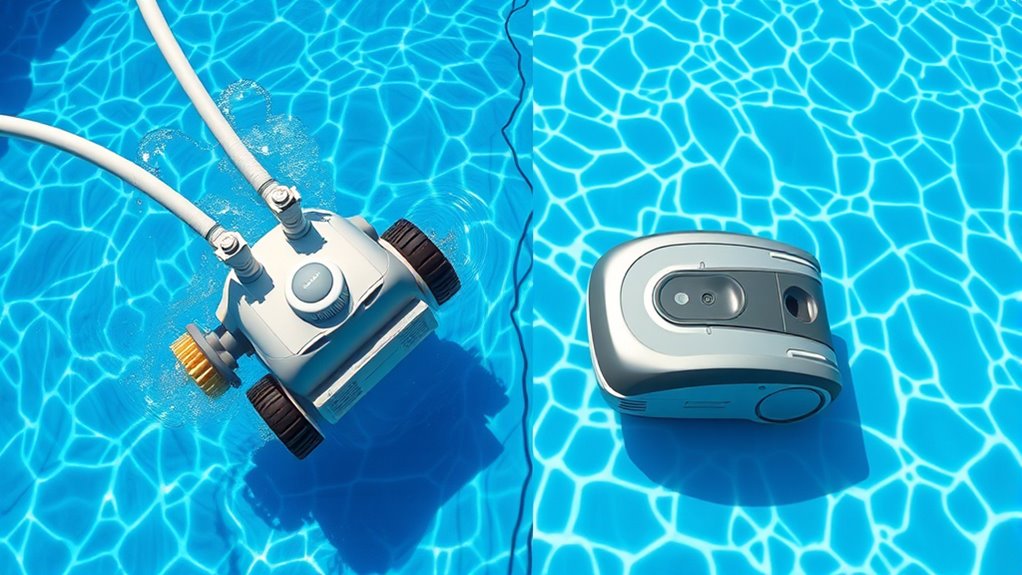
When comparing pressure and robotic pool cleaners, cleaning performance is key. You’ll want to contemplate how well each type removes dirt and debris, how quickly they cover the pool, and their ability to handle stubborn grime. Understanding these factors helps you choose the most effective option for your pool maintenance needs. Additionally, considering the maintenance costs associated with each type can impact their long-term effectiveness and value.
Dirt and Debris Removal
Have you ever wondered how effectively a pool cleaner removes dirt and debris? The answer depends on several factors. Here are three key points to contemplate:
- Filter types: High-quality filters trap fine dirt and debris, preventing them from recirculating. Effective filtration is essential for maintaining water clarity and hygiene.
- Hose length: Proper hose length ensures full coverage of your pool’s surfaces, reaching every nook and cranny.
- Cleaning power: Robotic cleaners often have stronger suction and better brush systems, making them more effective at removing stubborn debris. Additionally, understanding the relationships involved in pool maintenance can help inform your choice of cleaning equipment, ensuring a more thorough and efficient cleaning process.
Pressure cleaners might struggle with fine dirt, especially if the filters aren’t ideal or the hose is too short. Robotic models generally excel in dirt removal, thanks to their advanced filtration and thorough coverage.
Cleaning Speed and Coverage
Robotic pool cleaners typically offer faster cleaning speeds and more extensive coverage than pressure models. With their efficient motors and precise navigation, they can cover larger areas of your pool in less time. This means you spend less time waiting for the job to finish and more time enjoying your clean pool. Their cleaning speed allows them to quickly address dirt and debris across the entire coverage area, ensuring no spot is missed. Unlike pressure cleaners, which often follow random paths, robotic units are programmed to optimize coverage, making the process more thorough. If you want a quick, all-encompassing clean that leaves your pool spotless, a robotic cleaner’s superior cleaning speed and extensive coverage make it the smarter choice. Additionally, many robotic cleaners incorporate advanced navigation technology, allowing them to adapt to complex pool shapes and obstacles for comprehensive cleaning. Furthermore, their ability to adapt to advanced algorithms ensures more efficient and thorough cleaning sessions.
Deep Cleaning Capabilities
Robotic pool cleaners excel in deep cleaning by effectively targeting stubborn dirt, algae, and debris that often cling to pool surfaces. They improve water circulation, helping distribute chemicals evenly and maintain proper chemical balance. This enhances overall cleaning performance, especially in hard-to-reach areas. To maximize their deep cleaning capabilities, consider these factors:
- Strong suction power ensures debris is lifted from surfaces and filtered out efficiently.
- Advanced scrubbing brushes break down algae and grime for thorough cleaning.
- Smart navigation systems allow robotic cleaners to systematically cover every inch of your pool, ensuring no spot is missed.
Ease of Use and Maintenance
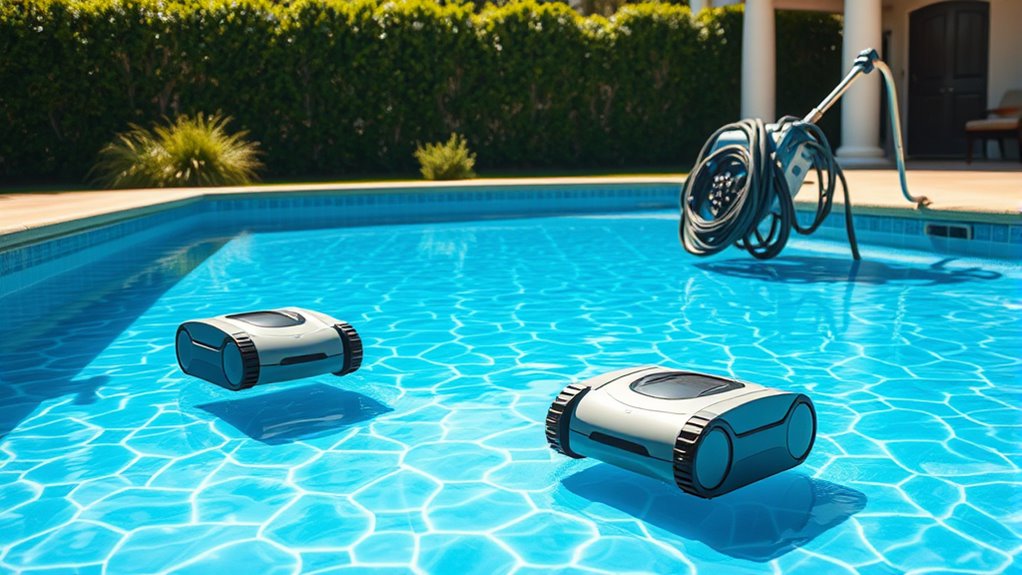
When choosing between pressure and robotic pool cleaners, ease of use and maintenance are key factors. You’ll want to take into account how simple it is to set up and install each type, as well as how much effort is needed for regular cleaning and repairs. Understanding these aspects helps ensure you pick a system that fits your routine and keeps your pool in top shape.
Setup and Installation
Setting up and installing a robotic pool cleaner is generally straightforward, making it accessible even for first-time users. Most models come with clear installation guides and user manuals to help you through the process smoothly. To get started, consider these key steps:
- Read the installation guide thoroughly to understand the setup process.
- Place the cleaner in the pool and connect it to the power source as instructed.
- Ensure the filters are properly installed and the robot moves freely.
Many robotic cleaners are designed for easy setup, often requiring just a few minutes. By following the detailed instructions in the manuals, you can install your device confidently and enjoy hassle-free operation from the start.
Cleaning and Maintenance
Once your pool cleaner is installed correctly, keeping it in top shape becomes straightforward. You should regularly check the battery life, especially if you have a robotic cleaner, to guarantee it runs efficiently. A fully charged battery provides longer cleaning cycles and better coverage. Pay attention to the noise level during operation; quieter models are easier to use without causing disruptions. Cleaning the filters and removing debris from intakes keeps your device functioning smoothly. For robotic cleaners, routine maintenance involves inspecting brushes and replacing worn parts as needed. Pressure cleaners generally require less maintenance but should be checked for clogs or buildup. Staying on top of these simple tasks ensures your pool cleaner performs at its best, extends its lifespan, and makes your pool cleaning experience hassle-free.
Troubleshooting and Repairs
Troubleshooting and repairing your pool cleaner can seem intimidating, but with a few simple steps, you can quickly identify and fix common issues. Start by checking the filter—if it’s clogged, replace it to restore ideal flow. Next, inspect the motor for troubleshooting: listen for unusual noises or signs of overheating, which may indicate a problem. Finally, examine the hoses and brushes for blockages or wear.
Here are three key steps:
- Perform filter replacement regularly to maintain efficiency.
- Troubleshoot motor issues by checking power supply and listening for irregular sounds.
- Clean or replace worn brushes and hoses as needed.
Addressing these areas helps ensure your cleaner runs smoothly and prolongs its lifespan.
Energy Consumption and Efficiency
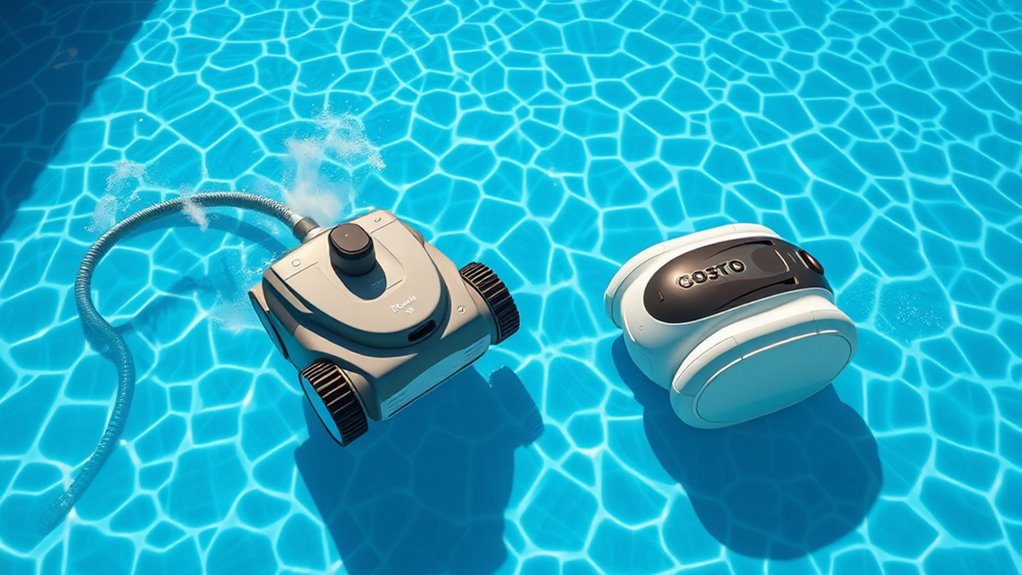
Robotic pool cleaners are generally more energy-efficient than pressure-side models because they operate independently of the pool’s filtration system, consuming less power during cleaning cycles. This independence means they use only the energy needed to power their motors and navigation systems, leading to lower overall power consumption. Their optimized cleaning algorithms ensure they work efficiently without wasting energy on unnecessary movements. In contrast, pressure-side cleaners rely on the pool’s pump, which increases energy use because the pump runs more frequently and at higher speeds. As a result, robotic cleaners typically have better energy efficiency, helping you save on electricity bills. If you want a cleaner that minimizes power consumption while maintaining effective cleaning, robotic models are the better choice.
Durability and Longevity
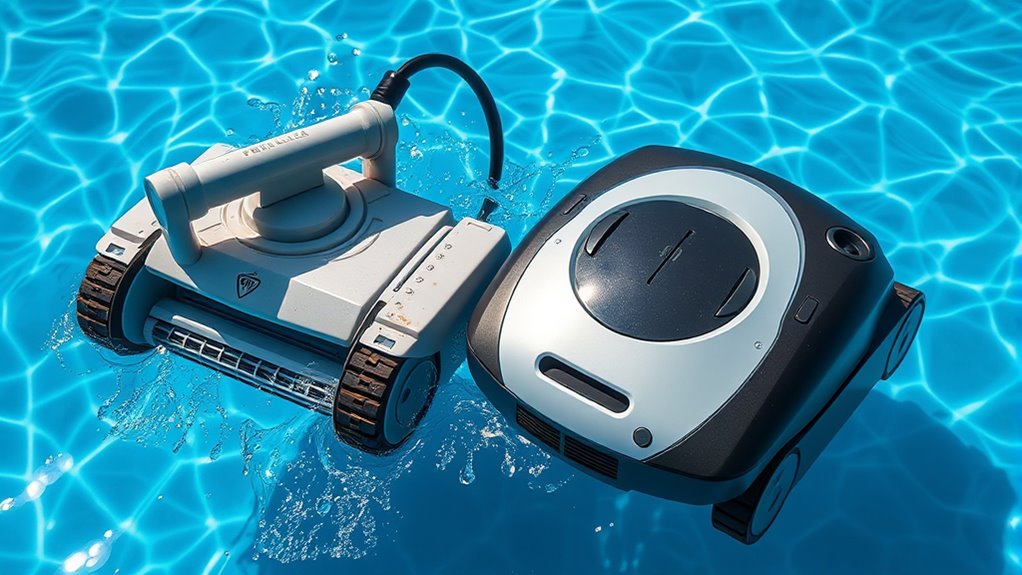
You want your pool cleaner to last, so consider the durability of its construction materials. Regular maintenance can reduce repair needs and extend its lifespan. Choosing a model built with high-quality components guarantees you get the most value over time.
Durability of Construction Materials
When evaluating pressure and robotic pool cleaners, the durability of their construction materials plays a crucial role in determining their long-term performance. You want materials with high material strength to withstand constant use and impact. Corrosion resistance is equally important, especially since pool environments involve water and chemicals that can degrade components over time. Consider these key factors:
- Material Strength: Ensures the cleaner can handle debris and rough surfaces without damage.
- Corrosion Resistance: Protects internal parts from rust and chemical corrosion, extending lifespan.
- Build Quality: High-quality plastics and metals maintain integrity under continuous operation.
Choosing a cleaner with durable construction materials guarantees better longevity and fewer replacements, saving you money and hassle over time.
Maintenance and Repair Needs
Since durability directly impacts how often you’ll need to perform maintenance or repairs, choosing a cleaner with sturdy construction can save you time and money in the long run. Regular upkeep involves checking filter types—whether cartridge, sand, or DE filters—and replacing or cleaning them as needed to ensure peak performance. Robotic cleaners often come with warranty options that cover parts and repairs, giving you peace of mind. Pressure cleaners, on the other hand, may require more frequent repairs due to moving parts and hoses. To minimize downtime, select a model known for resilience and extensive warranty coverage. Proper maintenance, including timely filter replacements and understanding warranty terms, helps extend your cleaner’s lifespan and keeps your pool pristine with less hassle.
Ideal Pool Types and Sizes
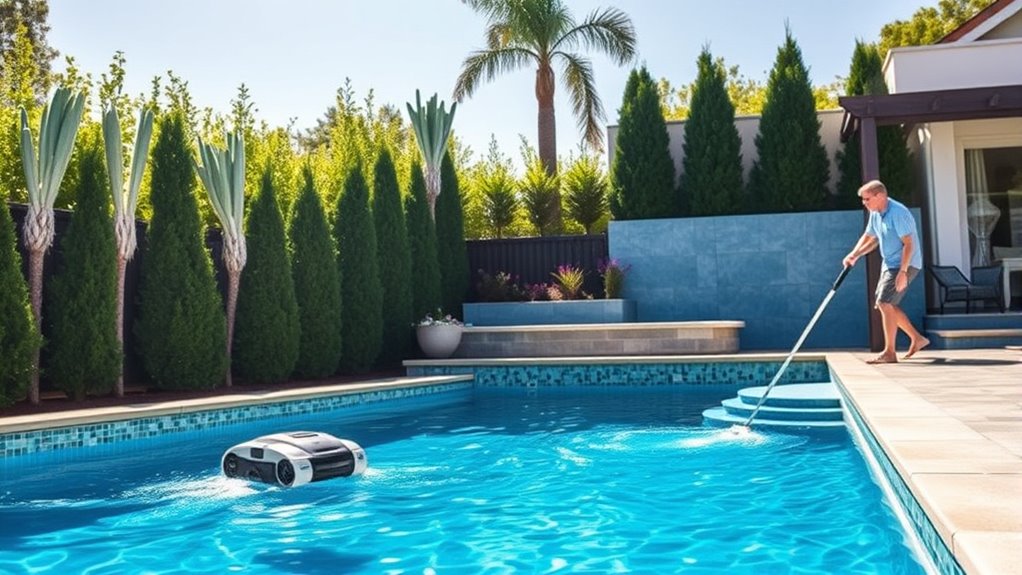
Choosing the right pool cleaner depends heavily on the type and size of your pool. Your pool’s shape and water chemistry influence which cleaner works best. For example, larger pools with irregular shapes may benefit from robotic cleaners that navigate complex surfaces easily. Smaller, round pools might be easier to clean with pressure models. Consider these factors:
- Pool shape – Irregular shapes require more maneuverable cleaners.
- Pool size – Larger pools need more efficient coverage.
- Water chemistry – Balanced water reduces debris buildup and prolongs equipment life.
Robotic cleaners excel in pools with complex shapes and varied surfaces, while pressure cleaners suit straightforward, smaller pools. Matching your pool type and size with the right cleaner guarantees effective, hassle-free maintenance.
Making the Right Choice for Your Pool
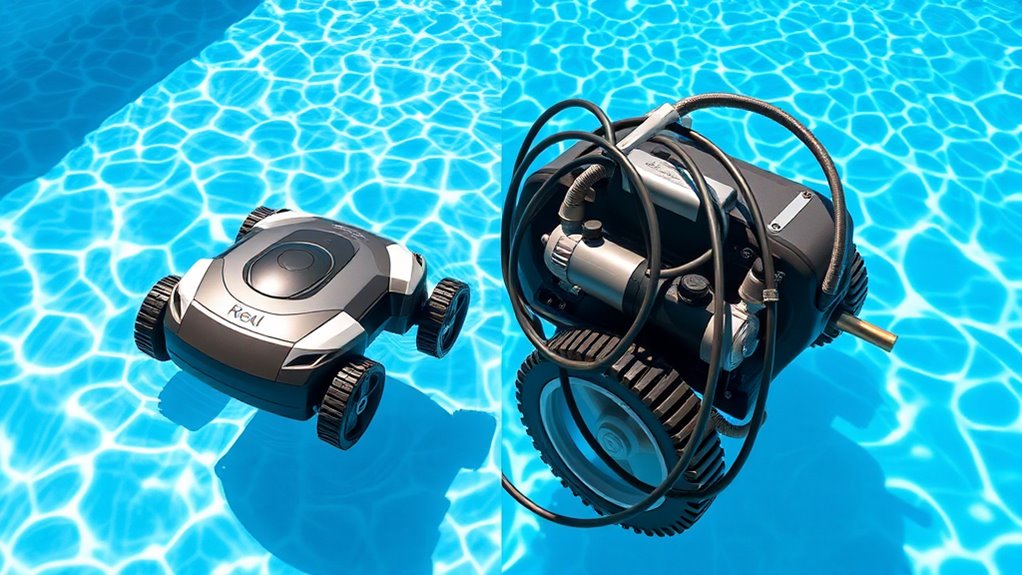
Selecting the right pool cleaner depends on understanding your specific needs and how you use your pool. Consider your pool’s size, shape, and surface material, as these influence whether a pressure or robotic cleaner is best. Pool safety is also vital; a cleaner that effectively removes debris reduces slipping hazards and promotes a safe swimming environment. Additionally, water chemistry impacts your choice—robotic cleaners often have built-in filters that help maintain proper water balance, while pressure cleaners can sometimes disturb delicate chemical levels. Think about maintenance routines and energy efficiency as well. By evaluating these factors, you can choose a cleaner that keeps your pool pristine, safe, and well-maintained, ensuring an enjoyable swimming experience all season long.
Frequently Asked Questions
Which Cleaner Is Better for Uneven or Textured Pool Surfaces?
When choosing a cleaner for uneven or textured pool surfaces, consider surface adaptability and texture performance. You want a device that navigates challenging terrains efficiently. Robotic pool cleaners excel in this area because their advanced navigation systems and flexible brushes adapt well to textured surfaces, ensuring thorough cleaning. Pressure cleaners may struggle with uneven spots, but robotic models often deliver better results on complex, textured pools.
How Do Pressure and Robotic Cleaners Handle Heavy Debris or Algae?
When dealing with heavy debris or algae, effective debris management and algae removal are key. Pressure cleaners use powerful jets to dislodge debris and algae from surfaces, making it easier to vacuum or filter out. Robotic cleaners, on the other hand, use advanced brushes and suction to target algae and debris directly, often covering surfaces more thoroughly. Both types can handle tough conditions, but robotic cleaners typically offer more efficient algae removal.
Are There Environmental Impacts Associated With Each Type?
Imagine uncovering hidden consequences behind your pool cleaning choices. The environmental impact of these cleaners varies; robotic models often use less energy, reducing your carbon footprint, but some may contain parts that are harder to recycle. Pressure cleaners tend to consume more energy, possibly increasing environmental strain. Your decision influences not just your pool’s cleanliness but also the broader ecological balance—so choose wisely, considering energy consumption and sustainability.
Can These Cleaners Be Used in Saltwater Pools?
You can definitely use pressure and robotic pool cleaners in saltwater pools. Just make certain they’re saltwater compatible, meaning they won’t corrode or malfunction over time. Many eco-friendly options are designed specifically for saltwater, helping you maintain your pool’s cleanliness without harming the environment. Always check the manufacturer’s guidelines to confirm saltwater compatibility, and choose models built to withstand the corrosive effects of salt for long-lasting, efficient cleaning.
What Safety Features Should I Look for in Pool Cleaners?
Imagine you’re relaxing by your pool when your cleaner suddenly gets stuck. To avoid mishaps, look for safety features like safety certifications ensuring it meets industry standards. An emergency shutoff is essential, so if the device detects a problem, it stops immediately, preventing damage or accidents. Prioritize these safety features to keep your pool cleaning safe, efficient, and worry-free, giving you peace of mind during every clean.
Conclusion
Choosing between pressure and robotic pool cleaners is like selecting your knight for a noble quest—each has its strengths. Picture a steadfast guardian tirelessly patrolling your pool, keeping it pristine like a castle moat. By understanding their features and your needs, you’ll find the perfect match. With the right cleaner, your pool transforms into a sparkling oasis, inviting you to immerse yourself in refreshment and relaxation, just as a castle’s moat beckons with promise of serenity.
